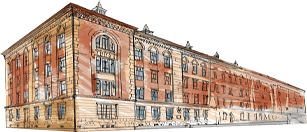I am sitting at the Jaffa Gate in Jerusalem. Between the Armenian and Christian district.
Jerusalem, surrounded by a wall by Suleiman the Magnificent, with eight gates leading to it, builds its balance by dividing into Jewish, Christian, Armenian and Muslim.
I watch the crowd flowing by, drinking black tea with fresh mint leaves. That’s how they serve it here. An old Arab in kefiya (called by us arafatka) attracts the eye, religious Jews celebrate the Sabbath, priests rustle with cassocks, tourists look for souvenirs and good shots, a local seller pushes a small trike with supplies, a group of pilgrims in identical hats approaches, a baker carries a huge tray on his head with sesame pretzels. Confessions and habits of nuns are mixed up.
The famous Israeli poet Yehuda Amikai used to sit in this place. In the poem “Turyści” he complained that the thousands of years of the city’s history are obscured by the current life:
Once I was sitting on the steps outside the gate of David’s keep, both of them
I put the heavy bags next to me. There was a group of tourists there
around the guide and served them as a landmark. “You see
the man with the bags? It’s a little to the right of his head
arch from the Roman period. A bit to the right of his head. But
has shifted! Shifted! I said to myself:
Liberation will come if they are told:
See that arch from the Roman period over there?
No matter, next to him, a little to the left, below, he is sitting
the man who bought vegetables and fruit for his home “
And in another poem he said that in the holy city of Jews, Christians and Muslims “the air is saturated with prayers and dreams like smog”. It cannot be otherwise, because the present Jerusalem, plundered and torn down and rebuilt again, lies on seventeen layers of ruins. This is what our guide explains. I wonder how many lives are hidden in this peculiar cemetery where the present city grew up. Although in spite of it, almost in the city center, in the basilica under the gray dome, not the most recognizable and the most splendid one – because it is made of gold, there is an “empty tomb”. The tomb of him who, as his disciples made known to the whole world, is risen. For us Christians, it is a hope that, in a sense, illuminates the city.
Jerusalem shines in the sun with beige sandstone and the mosque of the Dome of the Rock, and in the evening it glistens with lights that light up here and there on its wide, gentle hills, like a woman lying down to sleep. And so continues the fragile harmony of the city between Muslims, Jews and Christians.
Ewa Lubińska





